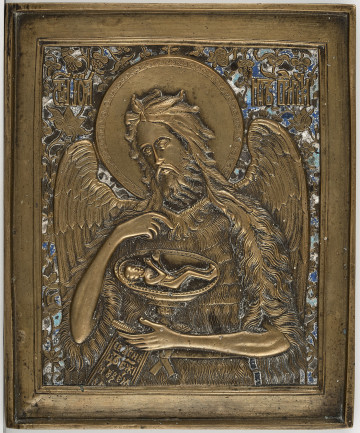
St. John the Baptist
20th century
Castle Museum in Łańcut
Part of the collection: Icons
The image of the Mother of God the Life-giving Spring, such as the presented brass casting decorated with enamel, only became popular in Russian Orthodoxy from the 17th century onwards. The composition begins with a well-known event occurred in Byzantium. According to legend, a Byzantine soldier once met near the Golden Gate of Constantinople a thirsty blind man who got lost. The soldier, rushing to help the man in need and looking for water in vain, heard a voice telling him to go to a nearby grove, where he came across a hidden spring. More strangely, the same voice called the soldier an emperor. Understanding that it was the Mother of God speaking to him, the soldier obeyed all orders, and having found water, had the blind man drink it and washed his eyes – the blind man regained his sight. Only a few years later, the benefactor obedient to the voice of the Divine Mother, became Byzantine emperor in 457. He was Leo I (the Great), who ruled until 474. Remembering the extraordinary event, the emperor had a temple dedicated to the Mother of God built near the miraculous spring where many healings took place. In this Orthodox church there was an icon of the Mother of God. Today, only a small chapel with a copy of the icon of the Mother of God the Life-Giving Spring, reminds of the church destroyed by the Turks. Images of Mary in the orans position, i.e. standing with her arms outstretched prayerfully are among the oldest in Christianity. The frontally depicted Mother of God holding the Child was called in Byzantium, in Greek, the ruler – “Kiriotissa” or the victorious ruler – “Nikopeia Kiriotissa”. In the icons of the Life-giving Spring, the Mother of God with the Child, depicted in a well, water feature, fountain or bowl with flowing streams of water symbolises the Spring of Life as the Mother of Christ who is the Way, the Truth and the Life. The icon can be found in many variants in Greece and Russia, where it is praised on April 17 (April 4 according to the Julian calendar) and on the Friday of the Paschal Week. Teresa Bagińska-Żurawska https://orcid.org/0000-0002-9243-3967
Dimensions
height: 12.3 cm, width: 9 cm
Object type
Icons
Technique
cast, enamelling
Material
brass, varnish enamel
Origin / acquisition method
decyzja administracyjna
Creation time / dating
Creation / finding place
Owner
Castle Museum in Łańcut
Identification number
Location / status

20th century
Castle Museum in Łańcut

19th (?) century
Castle Museum in Łańcut

1800 — 1850
Castle Museum in Łańcut
DISCOVER this TOPIC
Museum of King Jan III's Palace at Wilanów
DISCOVER this PATH
Educational path